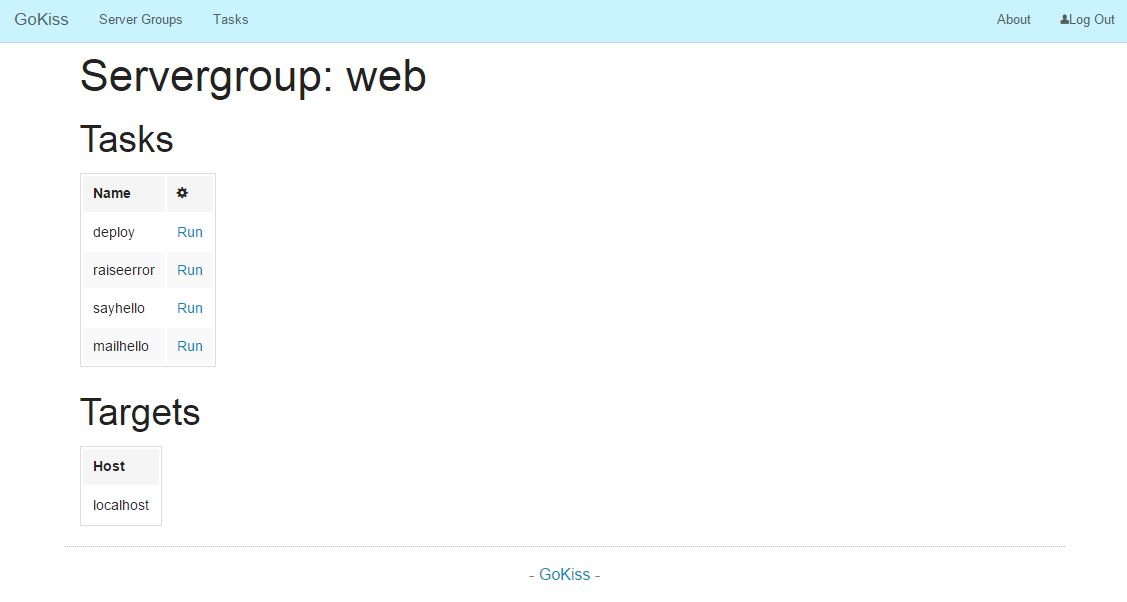GoKiss (by team go_ne)

Inspiration
James runs a few hobby projects on a VM.
Tobias helps manage large-scale infrastructure for a multinational company.
We wanted to meet somewhere in the middle to create an easily set up, easy to use, highly configurable tool to help manage our infrastructures - small and large scale.
Overview
Kiss is a plugin-based automation tool which allows you to execute arbitrary tasks on a remote machine (or even locally). It is intended to make deployments easier.
You can interact with Kiss in three different ways:
- Via a Command Line Interface
- Via a web interface
- Using webhooks or periodic triggers
It is able to:
- Remotely execute scripts via SSH
- Locally execute scripts
(tested on Ubuntu Linux)
The execution of your tasks is driven by a YAML file. Each task consists of a number of steps. Tasks can be executed against a list of server groups (e.g. run task mysqldump against all servers in group db).
Having your deployment scripts in a local place gives you and your team a number of benefits:
- Team members don't have to remember how certain tasks have to be executed
- You can easily add additional tasks by modifying a single configuration file
- The configuration can be in version control (tasks don't get lost)
The plugin-based architecture allows you to control more complex deployment tasks.
This project has been developed during Gopher Gala 2015.
The CLI

For the CLI, the YAML file can be placed in your project's root folder (.kiss.yml).
Follow the example on Tobscher/go-example-app or do it manually:
Download the binary from GitHub:
$ go get github.com/gophergala/go_ne/kiss
You can start your deployment by running the following commands:
$ kiss -group=web -task=deploy
The commands above assume you have placed a .kiss.yml file in the root of your project. Here is an example
configuration file:
servergroups:
web:
- host: localhost
username: "vagrant"
password: "vagrant"
port: 2222
- host: www.example.org
username: "root"
key_path: "/path/to/private_key"
db:
- host: localhost
username: "vagrant"
password: "vagrant"
port: 2222
- host: db1.example.org
username: "db"
key_path: "/path/to/private_key"
- host: db2.example.org
username: "db"
key_path: "/path/to/private_key"
tasks:
setup:
steps:
- plugin: apt-get
options:
update: true
packages:
- "git"
- "golang"
- "python-setuptools"
- command: go version
- command: easy_install supervisor
- command: rm -rf example-app
- plugin: git-clone
options:
repo: "https://github.com/your-fork/go-example-app.git"
directory: "example-app"
- command: cp example-app/supervisord.conf /etc/supervisord.conf
- command: supervisord || echo "Looks like supervisord is already running"
deploy:
steps:
- plugin: whoami
- plugin: env
- command: supervisorctl stop example-app
- command: cd example-app && git pull
- command: cd example-app && go test -v
- command: cd example-app && go build -v
- command: supervisorctl start example-app
- command: curl http://your.server.org:8080/
start:
steps:
- command: supervisorctl start example-app
stop:
steps:
- command: supervisorctl stop example-app
(If the server is to operate locally, use run_locally: true instead of ssh username/password/key_path).
TIP: You can use our test application to test the steps above: https://github.com/Tobscher/go-example-app
Options
-group
$ kiss -group=web
Defines the group for which the task should run. This flag is mandatory.
-task
$ kiss -task=deploy
Defines the task that should run. This flag is mandatory.
-config
$ kiss -config=.kiss-staging.yml
Defines the config file which includes the task definition. Default .kiss.yml
The Web Interface

[Note: the web interface is currently less complete than the CLI and has some messaging issues]
To start the daemon/web interface, build and run it:
$ cd go_ne/daemon/
$ go build -o daemon.exe
$ daemon.exe
The configuration file is the same format as for the CLI, but since it's running as a web facing daemon, we can set up triggers (currently GitHub Webhooks and periodic jobs are supported).
Configuration
An example configuration looks like this:
servergroups:
web:
- host: localhost
username: "vagrant"
password: "vagrant"
port: 2222
- host: www.example.org
username: "root"
key_path: "/path/to/private_key"
db:
- host: localhost
username: "vagrant"
password: "vagrant"
port: 2222
- host: db1.example.org
username: "db"
key_path: "/path/to/private_key"
- host: db2.example.org
username: "db"
key_path: "/path/to/private_key"
tasks:
setup:
steps:
- plugin: apt-get
options:
update: true
packages:
- "git"
- "golang"
- "python-setuptools"
- command: go version
- command: easy_install supervisor
- command: rm -rf example-app
- plugin: git-clone
options:
repo: "https://github.com/your-fork/go-example-app.git"
directory: "example-app"
- command: cp example-app/supervisord.conf /etc/supervisord.conf
- command: supervisord || echo "Looks like supervisord is already running"
deploy:
steps:
- plugin: whoami
- plugin: env
- command: supervisorctl stop example-app
- command: cd example-app && git pull
- command: cd example-app && go test -v
- command: cd example-app && go build -v
- command: supervisorctl start example-app
- command: curl http://your.server.org:8080/
start:
steps:
- command: supervisorctl start example-app
stop:
steps:
- command: supervisorctl stop example-app
Additional Daemon Configuration
The daemon also supports a 'triggers' block.
The following responds to the GitHub webhook on /gokiss/triggers/gitpush by running the deploy task on the web servergroup.
It also runs a periodic job every day (86400 seconds), running the mysqldump task on the db servergroup.
triggers:
githubrepopush:
type: github-webhook
endpoint: gitpush
secret: mygithubsecrethere
servergroup: web
task: deploy
monitor:
type: periodic
period: 86400
servergroup: db
task: mysqldump
The web setup is configurable. This serves from domain:port/gokiss/ and configures one user, gokiss with password default.
interfaces:
web:
settings:
folder: /gokiss
port: 20000
sessionsecret: e53cr3t5h3re
users:
- username: gokiss
password: default
Options
-config
You can also specify the location of the config file for the daemon (default is /config/test-tasks.yaml):
$ daemon.exe -config=.kiss.yml
Plugins
How plugins work
We make use of a communication concept called RPC. RPC allows
us to communicate with plugins in an elegant way.
NOTE: Your plugin has to start with the prefix plugin- in order to be revealed by the plugin framework.
Write your own plugin
You can easily write your own plugin by using our plugin framework. Here is an example:
package main
import (
"github.com/gophergala/go_ne/plugins/core"
"github.com/gophergala/go_ne/plugins/shared"
)
type Command struct {
}
func (t *Command) Execute(args shared.Args, reply *shared.Response) error {
*reply = shared.NewResponse(shared.NewCommand("env"))
return nil
}
func NewEnvCommand() *Command {
return new(Command)
}
func main() {
plugin.Register(NewEnvCommand())
plugin.Serve()
}
The example above defines a plugin which runs the env command on your server.
Please refer to the plugins directory for more examples.
Limitations
- Plugins will get a port assigned starting from 8000
- Plugins need to be prefixed wit plugin-, e.g. plugin-apt-get
- Some tasks require sudo
- Daemon has problems running remote tasks [partly patched in a branch]
- The Web interface should run under SSL
- The configuration file could take a variable block
- Results from tasks could be assigned to variables and feed into other tasks, or branch the flow (so periodic server monitoring => alert emails could then be possible)
Contributing
We hope you find this project useful. Please help us build upon it!
- Fork it ( https://github.com/gophergala/go_ne/fork )
- Create your feature branch (
git checkout -b my-new-feature)
- Commit your changes (
git commit -am 'Add some feature')
- Push to the branch (
git push origin my-new-feature)
- Create a new Pull Request

License
MIT License. Copyright 2015 James Rutherford & Tobias Haar.